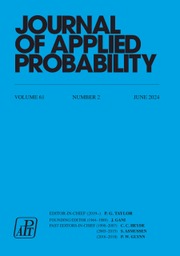Article contents
Last exit time until first exit time for spectrally negative Lévy processes
Published online by Cambridge University Press: 24 January 2025
Abstract
We study the last exit time that a spectrally negative Lévy process is below zero until it reaches a positive level b, denoted by  $g_{\tau_b^+}$. We generalize the results of the infinite-horizon last exit time explored by Chiu and Yin (2005) by incorporating a random horizon
$g_{\tau_b^+}$. We generalize the results of the infinite-horizon last exit time explored by Chiu and Yin (2005) by incorporating a random horizon  $\tau_b^+$, which represents the first passage time above b. We derive an explicit expression for the joint Laplace transform of
$\tau_b^+$, which represents the first passage time above b. We derive an explicit expression for the joint Laplace transform of  $g_{\tau_b^+}$ and
$g_{\tau_b^+}$ and  $\tau_b^+$ by utilizing a hybrid observation scheme approach proposed by Li, Willmot, and Wong (2018). We further study the optimal prediction of
$\tau_b^+$ by utilizing a hybrid observation scheme approach proposed by Li, Willmot, and Wong (2018). We further study the optimal prediction of  $g_{\tau_b^+}$ in the
$g_{\tau_b^+}$ in the  $L_1$ sense, and find that the optimal stopping time is the first passage time above a level
$L_1$ sense, and find that the optimal stopping time is the first passage time above a level  $y_b^{\ast}$, with an explicit characterization of the stopping boundary
$y_b^{\ast}$, with an explicit characterization of the stopping boundary  $y_b^{\ast}$. As examples, Brownian motion with drift and the Cramér–Lundberg model with exponential jumps are considered.
$y_b^{\ast}$. As examples, Brownian motion with drift and the Cramér–Lundberg model with exponential jumps are considered.
Keywords
Information
- Type
- Original Article
- Information
- Copyright
- © The Author(s), 2025. Published by Cambridge University Press on behalf of Applied Probability Trust
References
- 1
- Cited by


